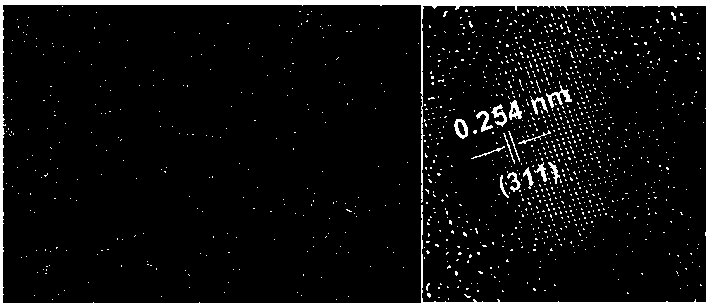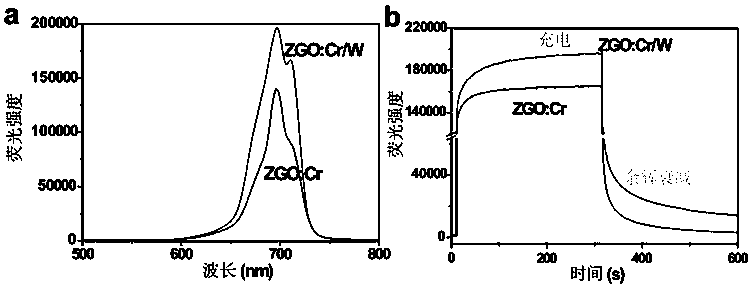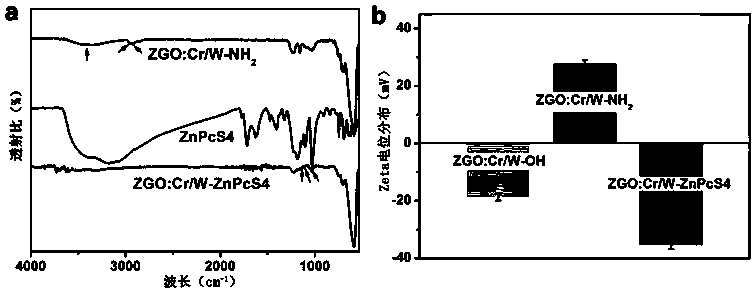Steady persistence nano material activated by low-dosage X rays and application thereof
A nanomaterial, long afterglow technology, applied in the field of medicine, can solve problems such as the limitation of photodynamic therapy, and achieve the effect of reducing the dosage, reducing side effects, and improving the therapeutic effect
- Summary
- Abstract
- Description
- Claims
- Application Information
AI Technical Summary
Problems solved by technology
Method used
Image
Examples
Embodiment 1
[0025] Example 1 Synthesis of Tungsten, Chromium Double Doped Long Persistence Nanoparticles
[0026] Weigh 0.2668 g Zn(NO 3 ) 2 •6H 2 O, 0.4565 g Ga(NO 3 ) 3 • xH 2 O, 0.0015 g Na 2 WO 4 • 2H 2 O and 0.0018 g Cr(NO 3 ) 3 •9H 2 O, mix and place in a 50 mL beaker, add 16 mL of ultrapure water, ultrasonically dissolve, stir rapidly at room temperature, then adjust the pH to 6.5 with ammonia water (28 wt%), a white precipitate is formed during the process, and continue stirring for 30 min , then transfer the mixture to a 25 mL autoclave, react at 180 °C for 12 h, then wash three times with 9000 rpm centrifugal water, dry in an oven at 60 °C, grind the obtained sample into powder, and calcinate in a muffle furnace at 950 °C 4h. Synthetic ZnGa 1.99 o 4 :0.005Cr, 0.005W (ZGO:Cr / W) long afterglow nanoparticles.
[0027] figure 1 The TEM image (a) and high-resolution TEM image (b) of the prepared ZGO:Cr / W long-lasting nanoparticles. Such as figure 1 As shown, it can ...
Embodiment 2
[0029] Example 2 Surface Amination of ZGO:Cr / W Long Persistence Nanoparticles
[0030] A small amount of ethanol was added to the ZGO:Cr / W long-lasting nanoparticle powder prepared in Example 1, wet ground for 30 min, and then the sample was ultrasonically dispersed in 10 mL of 5 mM NaOH solution for 3 h, and then stirred rapidly for 12 h. After the reaction, the dispersion was first centrifuged at 1000 rpm for 5 min to remove large particles, and then centrifuged at 8000 rpm to collect the precipitate, which was then centrifuged and washed once with water and once with DMF. The obtained precipitate was redispersed in 10 mL of DMF, and then 80 μL of aminopropyltriethoxysilane (APTES) was added, and the reaction was stirred rapidly in an oil bath at 85 °C for 12 h, and the aminated long-lasting particles (ZGO:Cr / W-NH 2 PLNPs), washed several times with DMF and water respectively to remove unreacted APTES, and finally dispersed in 5 mL water to make a concentration of 2.5 mg·m...
Embodiment 3
[0031] Example 3 Construction of Long Persistence Nanomaterials (ZGO:Cr / W-ZnPcS4)
[0032] Take 6 mL of 200 μg mL -1 The concentration of the photosensitizer ZnPcS4 prepared in Example 2 with 4 mL is 2.5 mg·mL -1 ZGO:Cr / W-NH 2 solution, mixed with ultrasound for 30min, and then reacted with rapid stirring at room temperature for 24h, and the obtained ZGO:Cr / W-ZnPcS4 nanoparticles were centrifuged and washed three times at 8500 rpm to remove excess ZnPcS4, and then redispersed in 5 mL of ultrapure water. into a concentration of 2 mg·mL -1 ZGO:Cr / W-ZnPcS4 solution.
[0033] image 3 Infrared spectrum (a) and zeta potential (b) of the ZGO:Cr / W-ZnPcS4 nanoparticles prepared in Example 3. Such as image 3 As shown, ZGO:Cr / W-ZnPcS4 has been successfully constructed.
PUM
| Property | Measurement | Unit |
|---|---|---|
| Particle size | aaaaa | aaaaa |
Abstract
Description
Claims
Application Information
 Login to View More
Login to View More - R&D
- Intellectual Property
- Life Sciences
- Materials
- Tech Scout
- Unparalleled Data Quality
- Higher Quality Content
- 60% Fewer Hallucinations
Browse by: Latest US Patents, China's latest patents, Technical Efficacy Thesaurus, Application Domain, Technology Topic, Popular Technical Reports.
© 2025 PatSnap. All rights reserved.Legal|Privacy policy|Modern Slavery Act Transparency Statement|Sitemap|About US| Contact US: help@patsnap.com



